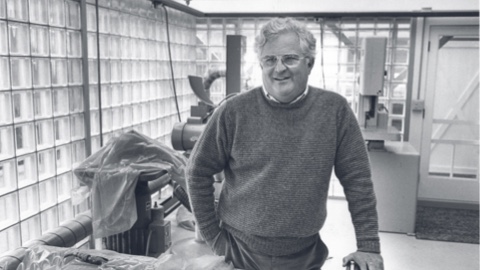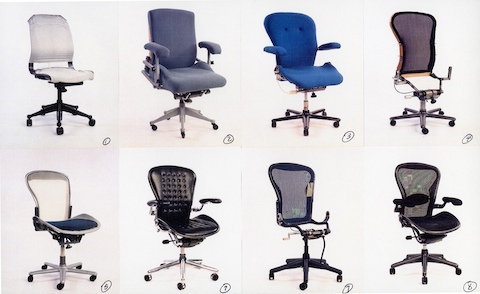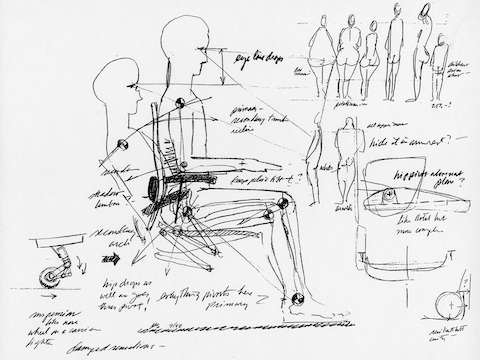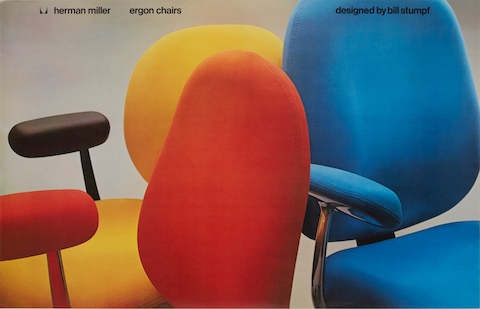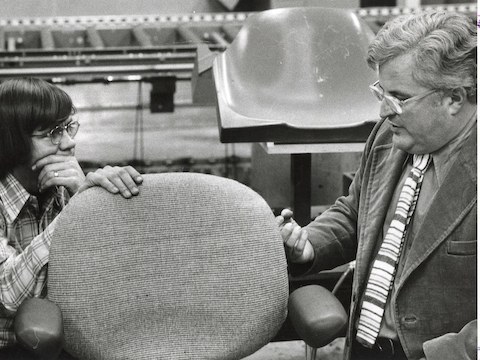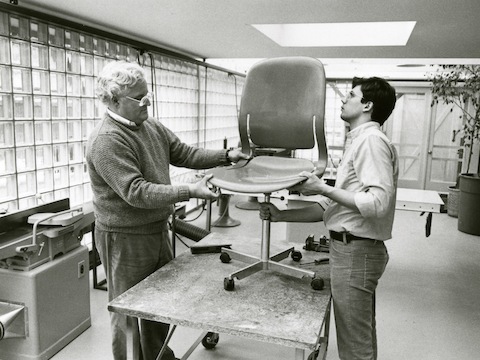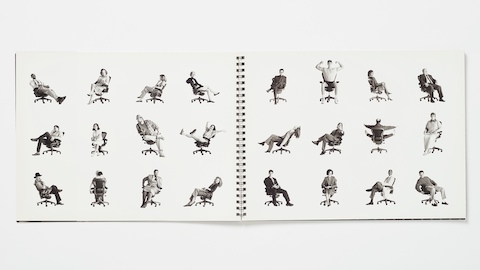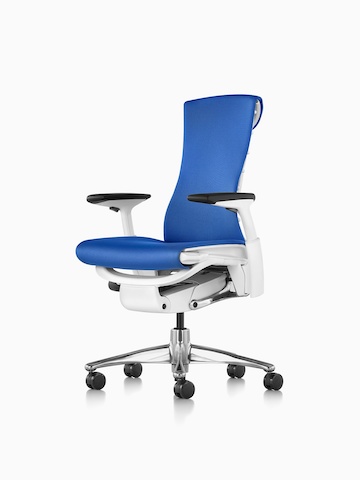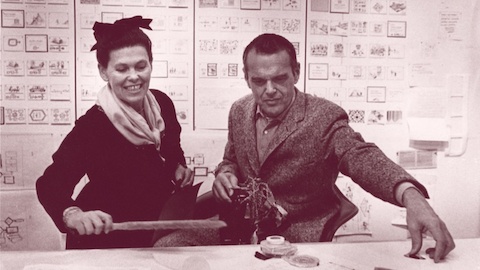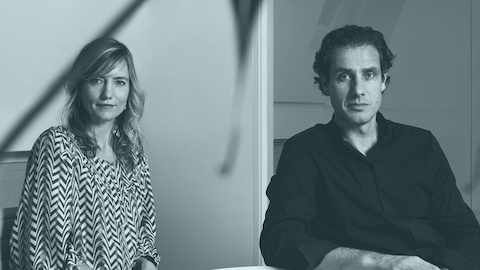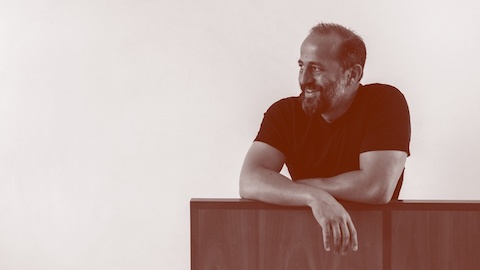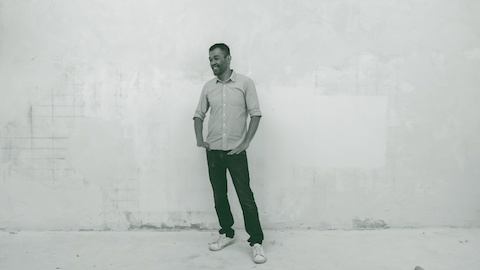To conclude our five-part Design Q & A series, we turn, in a way, to the man who inspired it: Bill Stumpf. Of course, the original Design Q & A comes from Charles and Ray Eames as both the basis of a 1969 exhibit Qu’est-ce que le design? (What Is Design?), held at the Musée des Arts Décoratifs in Paris and their seminal 1972 film of the same name. But it was the discovery of Stumpf’s lovely, literary, responses to the Eames questionnaire that got us at WHY thinking. What if we lead with the Eameses, talk to three of our favorite contemporary designers—Scholten & Baijings, Michael Anastassiades, and Keiji Takeuchi—and close with Stumpf?
What’s so striking about Stumpf’s responses is how humane they are. He’s less concerned with haute design, but rather, what he calls “the genial middle ground of everyday experience.” In a sense, Stumpf isn’t so much describing design as he is how we ought to treat each other. Design is one type of interaction, yes, but where he really sets his sights is, in a sense, civility, compassion, how to live, and ultimately how to live together. He put pen to paper in July of 1999, seven years before his death, and we’re thrilled to share, for the first time, Bill Stumpf’s Design Q & A.
What is your definition of design?
A means of creatively sustaining the arts of daily living in a technological world.
Is design an expression of art?
Design that resolves the frustrations of integration can be art.
Is design a craft for industrial purposes?
Yes. Yet industry can afford to bring craft to mass production and combine quality and low price. When a corporation commits itself, anything’s possible.
What are the boundaries of design?
The imagination.
Is design a discipline that concerns itself with only one part of the environment?
No. Design should be concerned with the genial middle ground of everyday experience.
Is it a method of general expression?
I wish it were, but the expression needs to be expanded beyond the visual arts. Giving form to things is only one role design has to play, albeit an important one. Design affects how we live, how we work, how we sustain the environment. Some of design’s power lies in the invisible, like the hidden goodness found in a toxin-free glass of tap water. Design is an act of optimism.
Is design a creation of an individual?
A more important question for the future is: Who are designers? Aren’t civil engineers designers? Would we not have more beautiful roads and bridges if they were? Or what’s the future of design? Much current design focuses upon things. Design will expand to create meaningful experiences in which things will play a part. Design needs an enlarged agenda and focus on needs like civility. We need to redesign law enforcement, for example. Or day care for children and older people.
Is design a creation of a group?
Let’s put it this way: many ideas come from the middle of the table.
Is there a design ethic?
Creativity is at the core of the design enterprise. Design is not a matter of technique, but a moral issue. As such, it also requires an ethical position.
Does design imply the idea of products that are necessarily useful?
Yes, but utility without play, as Horace will tell you, falls short of winning the game. Cities, work environments, or automobiles begin with utility; the truly successful ones transcend utility to express cultural dreams and enliven the spirit.
Is it [design] able to cooperate in the creation of works reserved solely for pleasure?
Pleasure by itself is no more worth a design issue than difficulty. Play is often tied to gratuitous difficulty and purposelessness. It is also often tied to a creative expression of humanity.
Ought form to derive from the analysis of function?
Functional analysis produces less frustration than integration. We need in the future to release art from the prisons we call museums and disperse it in the urban and rural landscape.
Does design imply industrial manufacture?
Perhaps less so than in the past. One is more concerned with the negative byproducts of manufacturing and sustaining the environment. More important are the questions of how and where things are made. We become isolated from the kinds of work and processes that make things, including food. Instead of factories becoming black boxes located in far-flung foreign or rural, low-labor-rate backwaters, they need to be seen. Are not restaurants with exposed kitchens a delight? Is it not intriguing to see an automobile being manufactured?
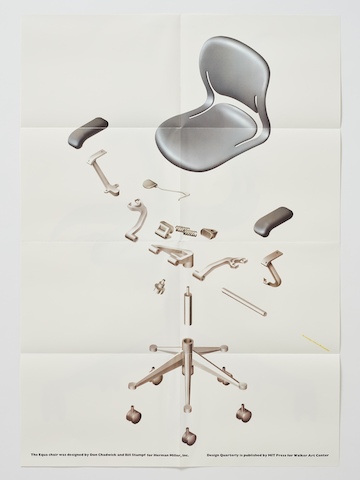
In 1984, the Walker Art Center in Minneapolis put on the show A Serious Chair and included this poster of Stumpf and Chadwick’s Equa Chair in its publication Design Quarterly.
Is design used to modify an old object through new techniques?
Yes, but happily design has learned it’s useful to modify new products with old techniques, like making good beer and growing organic food. Of course designing a comfortable work chair with no foam was fun, too.
Is design used to fix up an existing model so that it is more attractive?
Plastic surgeons would confirm this view. A better question would be: Isn’t it important to sustain an object through a lifecycle devoid of arbitrary change? Or make improvements to an existing process without destroying the edifice of the old? Our wonderful new-old baseball parks suggest the so-called “new design” in the past few decades spoiled the game, a game which wasn’t in need of change.
Is design an element of industrial policy?
In terms of global competition, design has become a matter of economic survival and in some nations a priority. Design in the future has serious implications yet to be recognized. If we applied one tenth of our defense budget to the arts of daily living, we could in one decade heal the wounds to the environment, care for the disabled and older people, provide wholesome daycare, launch a new commuting infrastructure, multiply job opportunities, integrate ourselves into a burgeoning, worldwide network information, knowledge, and wisdom, and above all reduce the burden of overly complex technology.
Does the creation of design admit constraint?
Constraints inform design, but like reality they can be an excuse for those lacking courage and imagination.
What constraints?
The number of constraints is less an issue than their nature. Good design resolves differences without destroying them.
Does design obey laws?
Design is often an act of civil disobedience that changes the laws. Still we have common sense and rules of thumb.
Are there tendencies and schools in design?
Convergence breeds products of vogue or a comfort zone for some designers and much of the design audience.
Is design ephemeral?
Design committed to universal consumption is as enduring as a butterfly’s wing.
Ought design to tend towards ephemeral or towards permanence?
Designs that become premature junk advertise a parting psychology in everyday life. Living on a finite planet, we will in the next millennium be better served by a life-conscious design. Objects are extensions of the needs of the living and as such take on the lust for life humans exhibit.
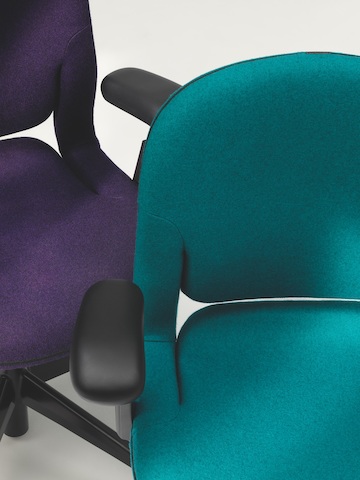
How would you define yourself with respect to a decorator? An Interior architect? A stylist?
In our hyper-connected society, designers are commercial artists. While I am uncomfortable with this definition, it remains truthful and inescapable. Will this change?
To whom does design address itself: To the greatest number? To the specialists or the enlightened amateur? To a privileged social class?
Design should mirror the hopes, freedoms, and opportunities promised and fulfilled by democracy.
After having answered all these questions, do you feel you have been able to practice the profession of “design” under satisfactory, or even optimum conditions?
I’m a very lucky man, I enjoy my work.
Have you been forced to accept compromises?
No human endeavor is immune from compromise. To repeat, I try to resolve differences without destroying them.
What do you feel is the primary condition for the practice of design and for its propagation?
Human rights and environmentalism. Design cannot exist apart from the great social concerns of the coming years. Truly great design has never existed apart from the human condition.
What is the future of design?
What is the future of life?
